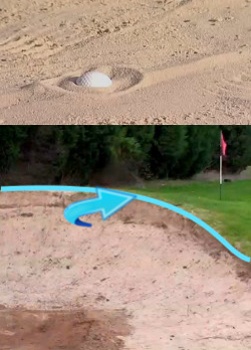
The untimely passing of Severiano “Seve” Ballesteros in 2011 unleashed an outpouring of adulation from fans and peers the world over. Nearly every description of the five-time major champion included two words not often associated with golfers: “artist” and “genius.”
Nowhere was Ballesteros' brilliance more evident than the confines of a bunker. Ballesteros had a penchant for altering his setup and swing to tackle any situation, from a buried lie to a severe downhill stance.
While there's no denying Ballesteros' natural gifts – hands so large he could cradle 11 balls in each, for example – imagination was the true force behind his artistry. As a kid, Ballesteros learned to visualize different shots and adapt his technique using only a 3-iron to whack balls across the beaches of Pedreña, Spain. In fact, he once challenged Jack Nicklaus and Ben Crenshaw to a bunker contest in which his fellow greats used their sand wedges, Seve his 3-iron. Ballesteros won, of course.
According to witnesses, the Spaniard flicked his ball out of the sand to the edge of the cup. Nicklaus and Crenshaw were stunned, but they shouldn't have been. Ballesteros was a once-in-a-lifetime virtuoso.

In a word, magic. Ballesteros concocted an array of jaw-dropping bunker shots from every conceivable position and lie.
How Ballesteros did it: While he epitomized the term “feel player,” there were certain constants to Seve's bunker technique. He took a very wide stance and lifted the club abruptly by cocking the wrists almost immediately. He also utilized a “chicken-wing” action with his left elbow, folding it upward to hold the clubface open through impact.

Fundamentals aside, Ballesteros was defined by his improvisational skills. He would adjust his stance, posture, clubface alignment, weight distribution and swing length to produce the ball flight, spin and roll he visualized.
How you can do it: For all his talent, Seve wasn't born with otherworldly bunker skills; he developed them on the beach and, later, the golf course. The real lesson is that technique can only take you so far, especially in the short game. Experience through trial and error is the best teacher.
If your local course or practice facility has a practice bunker, immerse yourself in it. Devote at least 30 minutes of each visit to blasting out of different lies, hitting the ball different distances, varying the height of your shots, playing shots that spin and others that bounce and roll. Use your sand wedge, of course, but try clubs with less loft, too. You'll be forced to change your stance, hand position and the angle of the clubface in order to get the ball out of the sand – and you'll develop a feel that translates into every aspect of golf.
Who knows, you may just tap into a genius you never knew was there.

Seve Ballesteros - The Artful Bunker Shot
Seve Ballesteros was one of the best golfers in the history of the game. Taken from the world far too early at the age of 54, Ballesteros recorded an incredible 91 professional wins during his career. Five of those wins came in major championships, with two Masters titles and three Open Championships to his credit. A member of the World Golf Hall of Fame, there can be no debate that Ballesteros has secured a place among the all-time best to walk the fairways.
To play golf at such an incredibly high level, one must have a complete set of skills from tee to green. Ballesteros, certainly, did have that set of skills. However, it is one area of his game specifically which will be remembered in golf history – his short game. It was common to hear Ballesteros referred to as a genius around the greens, and that word was certainly a fitting description. The up-and-down saves that Ballesteros made throughout his career set him apart from his competition, and were highly entertaining to golf fans around the world.
In this article, we are going to specifically address one component of Seve's short game – his bunker play. Amateur golfers frequently struggle to play quality shots from the bunker, but Seve made this part of golf look like an art form. Saving par from seemingly impossible situations was routine for the great Spanish golfer, and his opponents knew better than to assume Seve was out of a hole simply because he found his ball in a tough spot. With Seve, there was always the possibility of a magical bunker shot – even from the worst of places.
Of course, it is a daunting task to attempt to play bunker shots like Seve Ballesteros. In fact, it is more than daunting – it is downright impossible. Seve is likely the best in the history of the game at playing from the sand, so you can forget about rising to his level anytime soon. With that said, there are certainly bits and pieces you can take from his technique which can be applied to your own technique. In addition to watching his technique for pointers, you can also learn from the way Ballesteros approached the short game in general.
Remember, it is never a good idea to completely imitate the technique of another player. It is common for amateur golfers to attempt to copy the mechanics of their favorite players, whether it be the golf swing of Tiger Woods or the short game of Seve Ballesteros. Without exception, those attempts are doomed to fail right from the start. Your golf swing is your own, and you are not going to play well simply by copying someone else. Learn from elements of the techniques used by the world's best players, but remain true to yourself at the same time. By adding bits and pieces to your technique, you can gradually improve day after day and year after year.
All of the instruction included below is based on a right-handed golfer. If you happen to play golf left-handed, please take a moment to reverse the directions as necessary.

Mechanical Points
The majority of the genius of Seve Ballesteros' bunker play was his creativity and ingenuity. However, you must have solid fundamentals before any of those other attributes can come into play. To be sure, Seve had the necessary mechanics to allow his brilliance to show through in the results of his bunker shots. If you would like to learn from the mechanics Ballesteros' used when playing from the bunker, check out the points below –
- Lay the face open at address. One of the basic mistakes made by many golfers is the failure to lay the face of the sand wedge open at address. It is important to open the face because doing so will expose the bounce angle of the club to the surface of the sand. As you swing through, the bounce will allow the club to glide through the sand cleanly, lofting the ball up into the air. Many amateurs keep the face square at address, which causes the club to dig into the sand at the bottom of the swing. Don't make that mistake. Open up the face when you address the ball and keep it open through impact in order to carve the ball out of the bunker beautifully.
- Great footing. When you watch golf on TV, you have certainly noticed that the pros wiggle their feet down into the sand prior to playing a bunker shot. Why do they go to the trouble? Simple – wiggling your feet down into the sand will help you maintain traction as you swing. Sand is a slippery surface in many cases, but you should be able to keep your footing nicely after you have dug an inch or two into the bunker.
- Steep backswing. In order to hit down through the sand as needed for an explosion shot, you will want to make a rather steep backswing. To do so, Seve typically would set up with the majority of his weight on his left side. By leaning into your left side at address, the backswing will naturally become steeper and your downswing should plunge into the sand behind the ball as a result. In addition to using your weight to create a steep backswing, you also want to make sure that you set your wrists quickly after the swing begins. It is the combination of a left-leaning stance and active wrists which will allow you to hit down into the sand properly.
- Hold the face open. This is perhaps the most important tip of all when it comes to greenside bunker play. Ballesteros was excellent at holding the face of his wedge open through the hitting area in order to loft the ball perfectly into the air. If you allow your right hand to overtake your left – as it would do in a regular full swing – the club face will shut down and your shots will come out low, if they come out at all. As you swing through impact and into the finish, allow your left elbow to come up away from your side slightly. When this happens, you will be encouraging the club face to remain open through the sand and beyond. This technique takes a bit of practice since it is so different from what you should be doing while hitting off the grass. However, if you wish to become a quality bunker player, learning to hold the face open is of critical importance.
One of the biggest challenges that you will find in a greenside bunker is the fact that the swing you need to make is almost completely opposite of the rest of your swings. Proper bunker technique would be terrible technique to use on a full swing, so you have to learn this part of the game separate from everything else. Most amateur golfers never bother to learn how to play the right way from the sand, and they struggle to get up and down as a result. Rather than living the rest of your golfing life in fear of greenside bunkers, take on the challenge and learn to handle these shots properly. With the tips above in your back pocket, head to your local course and practice your bunker play as frequently as possible.

The Creative Side of the Equation
In the title of this article, we refer to the 'artful' bunker shots played by Seve Ballesteros. The world 'artful' is used for a reason – there was far more than mechanics in play when Ballesteros blasted the ball out of a bunker and up onto the green. To go along with his mechanics, Ballesteros had an incredible imagination and the ability to see shots that others would simply never imagine. Plenty of top level golfers have great technique in bunkers, but few have the kind of imagination and creativity that allowed Ballesteros to be so effective.
So what does this have to do with you and your game? Well, you need to open up your mind to be as creative as possible when in the bunker. Out of the bunkers, you don't need to be particularly creative to play some solid golf. As long as you make smart decisions, and execute your swings, you can position your ball nicely throughout the day. When your ball comes to rest in the sand, however, you will need to open up your mind and look for as many options as possible. You can never prepare for all possible bunker situations in practice, so it comes down to thinking on your feet and finding solutions to bunker problems as they come up on the course.
Creativity in golf is something that you have to develop on your own. We can't instruct you on exactly how to be creative, of course, because that's not how creativity works. Mostly, improving your creativity is going to come from experience. Practice your sand shots as much as possible and you will slowly but surely find more and more ways to get the ball up and down.
Although we can't give you step by step instructions on improving your creativity, the following points should help you move in the right direction.
- No preconceived notions. One of the worst things you can do is to walk down into the bunker with a plan for the shot already in place. You don't know what you are going to find when you get into the bunker, so don't decide on the kind of shot you will hit until you have a closer look at the situation. Among the variables you need to review in the bunker include your path to the hole, the lie of the ball, the distance of the shot, and more. Only after you have taken a close look at everything involved in the shot can you make a decision on how to proceed.
- Don't automatically reach for your sand wedge. As you practice bunker shots, be sure to work on your technique with more than just your sand wedge. Ideally, you will have at least two or three different clubs that you are comfortable using when playing from the sand. Depending on the lie of the ball and how far you have to reach the target, it may be necessary to move away from your sand wedge. Of course, you should never hit a shot on the course that you haven't tried in practice, which is why it is important to try out a few different clubs in the practice bunker.
- Have confidence in yourself. Many of the brilliant shots Seve Ballesteros hit throughout his career would never have been possible if he didn't have the courage and confidence to give them a try. Of course, he had every reason to be confident, as he had as much skill as anyone in the world in this part of the game. You won't be dealing with that level of skill, but you can still believe in yourself. Through practice, you can gradually build up your confidence to the point where you are willing to try a variety of different shots out on the course. Confidence is one of the best weapons a golfer can have in the bag, and that is certainly true with regard to playing from bunkers.
It is important to keep in mind just how much creativity goes into the average bunker shot. Since you can't rely on a clean lie in the sand like you can in the fairway, it is important to be creative and open-minded when you step down into the sand. In this part of the game, there is simply no substitute for experience. Spend time practicing your play from the sand and always look for new ways to play various shots. As time goes by, you should be able to add more and more options to your bunker game.

Monitoring Sand Conditions
The lie of your golf ball is always important, no matter what kind of shot you are trying to hit. Whether you are on the grass on in the sand, you always need to be aware of the lie you have drawn. A good lie will make it possible to play a wide variety of shots, while a poor lie will leave you struggling to even move the ball toward the target. In terms of bunker shots, you always need to be watching sand conditions as you play to make sure you know what to expect should your ball find a greenside trap.
Generally speaking, sand conditions are going to be relatively light and soft when the weather is dry, while they will be firm when rain is falling (or has recently fallen). Simply by checking the weather, you can have a pretty good idea of the type of sand that you will encounter. Soft sand makes it pretty easy to play a high bunker shot, however, your ball will be more likely to plug in the bunker when it comes down from way up in the sky. On the other hand, it is hard to play high bunker shots from firm, wet sand. The good news with regard to those kinds of conditions is the fact that you will almost always draw a good lie in wet sand, and you should be able to put plenty of spin on the ball as well.
In addition to the weather, you need to pay attention to the specific type of sand that has been used on the course you are playing that day. Should you be playing a course for the first time, look around to see if the facility offers a practice bunker for your use before starting your round. If not, ask in the pro shop for any tips related to the conditions of the sand. You don't want to head out onto the course with no idea of what to expect in the bunkers. Either through practice or through some advice from a local, do your best to plan ahead with regard to what you will see in the traps. As a professional golfer on a global scale, Seve Ballesteros was required to constantly adapt to unique sand conditions wherever he was playing. While you are unlikely to face the same challenge, you still need to pay attention to the condition of the sand each time you tee it up.

Moving Out of the Bunker
Seve Ballesteros was one of the best – if not the best – bunker players of all-time. With that said, it would be a mistake to note only Ballesteros' play from the bunkers without complimenting the rest of his incredible short game. Just as dangerous when chipping from the rough as when blasting out of the sand, Ballesteros was a threat to get up and down from anywhere he happened to find his golf ball.
As you are working on your bunker game, remember to spend some time working on your short game from the grass as well. You will likely encounter more chip shots than bunker shots during the average round, so it would be a mistake to focus so much on the sand that you are unprepared for playing from the grass. Unfortunately, the technique you need to use from the grass is dramatically different from what you will use in the sand, so you have to be willing to spend time perfecting two different techniques.
To take your chipping performance to a new level, take note of the following points.
- Get the ball on the ground ASAP. Many amateur golfers like to loft the ball up to the hole when they chip, carrying it as far as possible onto the green. This is usually a mistake. Instead of going up into the air, plan your chip shots by trying to get the ball down on the ground as quickly as possible and allow it to run the rest of the way to the cup. This is a far more reliable way to chip, and you should find that your results become more consistent when opting for this method.
- Respect the lie. You might want to spin the ball with your chip shot, but if you have a lie where the ball is sitting down in long grass, that simply won't be an option. Rather than trying to 'fight' the lie, respect what it says about your shot and stay within those limitations. If playing from long grass, for example, forget about backspin and do your best to roll the ball nicely up to the hole.
- Play it safe. It is common for amateur golfers to attempt to hit incredible chip shots from tough situations – and many of those shots end up missing the green entirely. As you are getting ready to hit a chip shot, you need to remember that it is essential to hit the green with your chip. Your next shot needs to be a putt, even if you aren't putting from as close to the hole as you would like. Trying to pull off a miracle chip shot might be an enticing proposition, but it will lead you into trouble more often than not. Be patient, play it safe with your strategy, and give yourself some kind of putt to save the up and down.
Without any question, Seve Ballesteros was one of the greatest golfers to ever play the game. While he had world-class skills from tee to green, his magic from the bunkers was one of the talents which earned him millions of fans. You don't have to worry about getting up and down from the sand in a major championship anytime soon, but you might have to make a big save in order to win a match against your friends. Invest some upcoming practice time working on your sand game and you should see benefits in short order. There may never be another player to match the ability of Seve Ballesteros playing from the sand, but you can learn from his example to improve on your own game.







